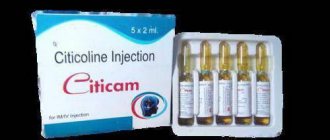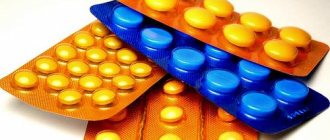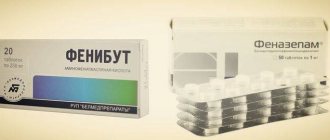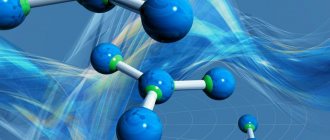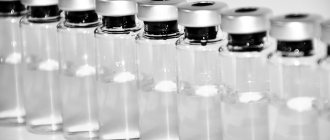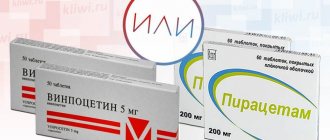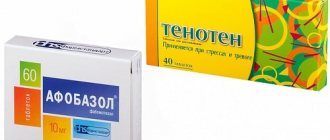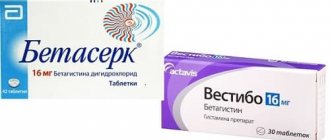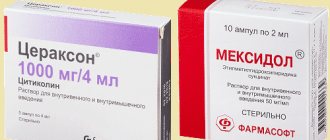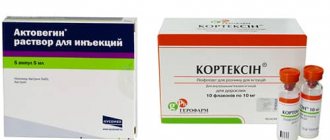Depressio.ru » Medicines » Nootropics
Piracetam is a nootropic drug that is prescribed for various pathologies of brain tissue metabolism. Since this is a Russian medicine, analogues of the drug Piracetam in substance are produced abroad, and on the domestic market of drugs there are its analogues in action, but with a different active ingredient.
- Composition and release form
- Analogues of the drug
- Lutsetam
- Nootropil
- Dendrix
- Kemodin
- Pramistar
- Selecting an analogue
Effect of the drug
The medicine belongs to the pharmacological group of nootropics. The action of Piracetam is aimed at stimulating cerebral circulation. As a result, the patient’s memory, speech, and emotional state improve. The medicine "Piracetam" helps improve brain metabolism and restore connections between the hemispheres. Increased blood circulation increases concentration and stimulates memory processes.
A big advantage of the drug is the absence of a sedative effect on the central nervous system. The drug is characterized by instant absorption and distribution through nerve tissues. The maximum concentration of the active substance is observed in the body after half an hour.
Medicine Memotropil
An analogue of the drug Piracetam is Memotropil tablets. By using analogues of Piracetam in tablets, you can save money or improve the quality of treatment
. In this case, the drug Memotropil is not a cheap drug, but it is much more effective than Piracetam in many pathologies of the body. The Piracetam analogue should be used not only in neurological practice, but also in psychiatry.
Memotropil tablets consist of an organic compound of non-proteinogenic aminobutyric acid or piracetam, a natural polymer, mealy potato carbohydrate, glycolic acid with sodium salt, stearic acid with magnesium, methyloxypropylcellulose, PEG 600, dietary supplement Sunset, silicate fatty powder, monopropyl glycol, titanium white.
Memotropil or an analogue of Pirocetam should be used for the following pathological conditions of the body:
- age-related dementia;
- history of Alzheimer's disease;
- in the rehabilitation period of ischemic stroke with speech impairment, mood changes, reduction in motor and psycho-emotional activity;
- in the treatment of alcohol dependence during the period of alcohol psychosis;
- unsteadiness of gait in discirculatory and dysmetabolic encephalopathy;
- with damage to the cerebellum;
- chemical intoxication of the central nervous system;
- brain concussion;
- cortical myoclonus;
- inability to concentrate and remember information in children with organic lesions of the right hemisphere of the brain.
The drug Memotropil is an analogue of Piracetam, which means that it exhibits a similar effect on the body. The drug helps the body absorb oxygen and thus reduces the need for oxygen in internal organs and systems. Has a pronounced positive effect on nerve cells and has a calming effect on muscle spasms
.
Has antioxidant protection
. The Piracetam analogue has the property of stimulating metabolism and microcirculation in nervous tissue.
The drug does not cause drowsiness and does not have a stimulating effect on the psycho-emotional state. The drug Memotropil, a modern analogue of Piracetam, has the ability to stop blood clots at the initial stage. Reduces the amount of fibrin and plasma glycoprotein in the blood plasma.
Indications for use
Despite the numerous analogues available, Piracetam is quite in demand for a variety of pathologies. The medicine is prescribed if the patient is diagnosed with:
- Chronic cerebrovascular insufficiency, which manifests itself as dizziness, pain, speech and memory disorders.
- Ischemic stroke and its consequences.
- Dementia – vascular, senile. Alzheimer's disease.
- Psychoorganic syndrome. Even those caused by alcoholism.
- Traumatic brain injury and its consequences.
- Acute neuroinfection of a viral nature.
- Consequences of intoxication. Including pathologies caused by taking morphine, barbiturates, ethanol, amphetamine.
- Pathologies of the nervous system, characterized by a reduced level of wakefulness, behavioral disorders, deterioration of intellectual functions, and emotional disturbances.
- Depression resistant to antidepressant treatment.
- Epilepsy.
The drug Piracetam is often included in combination therapy to combat sickle cell anemia. To prevent the development of vaso-occlusive crisis, the patient is recommended to take a tablet form of the drug. Piracetam injections can stop the pathological process.
The use of the drug is advisable for many pathologies: dizziness, sluggish state. It demonstrates an excellent effect in the treatment of neurological, somato-vegetative consequences resulting from the use of antipsychotic or psychotropic drugs.
The drug is in demand in pediatrics. It is prescribed for complications of central nervous system lesions, mental retardation, cerebral palsy, intellectual disability, mental retardation, memory impairment, speech disorders, and learning disabilities.
TOP 23 most popular analogues
We have collected 23 Piracetam analogues into one list, with an analysis of their pros and cons:
- Lucetam has more contraindications, but is cheaper. Wider range of applications in treatment.
- Memotropil has a wide range of uses and is characterized by the gradual development of stimulating effects that occur in the metabolic processes of the brain.
- Nootobril (Nootrobil). Among all nootropic drugs, Nootobril is more expensive, but has better purification, which will not cause side effects for the liver and kidneys.
- Nootropil is an increased dose of Piracetam and is much more expensive. May be prescribed by your doctor to more quickly achieve the expected effects.
- Noocetam practically does not cause sedative and psychostimulating effects, is cheaper than Piracetam, and has a number of restrictions for use.
- Pyrabene (Parabene) has greater purification, but is higher in price.
- Pyramem is used exclusively as prescribed by the attending physician.
- Piratropil (Paratrooper) has a narrower range of applications, is cheaper, and is prescribed in combination therapy.
- Stamin . Affordable price for Stamin, and a wider range of applications for the treatment of mental and neurological diseases.
- Cerebryl is a more expensive drug that can cause the least side effect from the category of neurometabolic stimulants.
- Escotropil (Isotropic) An inexpensive drug that has a direct effect and increases brain performance. Has a narrow range of applications.
- Noopept is a more expensive drug and is prescribed exclusively to adults (over 18 years of age).
- Biotropil (Biotropin) has a higher price, is prescribed exclusively to adults, and has a minimum number of side effects.
- Piracetam MS is inexpensive, prescribed to adults, contraindicated for those who have suffered a hemorrhagic stroke.
- Pantogam . The price of the medicine (syrup, tablets) is not high, but an allergy to the drug may occur.
- Phenotropil . The higher price is supported by a wide range of applications in the treatment of organs of the central nervous system.
- Mexidol . The low price of the new drug and a wide range of applications for the treatment of children and adults make this drug more universal and commercially available. Often prescribed in combination with Actovegin.
- Vinpocetine . An inexpensive drug, prescribed in combination with other drugs, synthesized on the basis of Vincamine, recommended as a food supplement, improves the functioning of the entire vascular system of the body.
- Cavinton . Affordable price, wide range of applications for the treatment of neurological and mental disorders, supported by the absence of side effects. Incompatible with Heparin.
- Cinnarizine . The low price makes this drug popular among those who buy drugs to calm the central nervous system. Use with caution by drivers and workers where it is important to demonstrate a quick physical and mental reaction.
- Phezam is classified as an antibiotic, combined nootropic drug. Recommended for changes in the body, disorders of the central nervous system, deterioration of blood circulation and the functioning of the vascular system.
- Omaron . The more expensive drug Omaron is prescribed for complex treatment of the central nervous system. Prescribed after strokes as a supportive agent for cerebral circulation.
- Phenibut is much more expensive than Piracetam. It has a wide range of uses for children and adults. In combination, to achieve the desired effect, it is used with tranquilizers and antipsychotics. When taken simultaneously with other drugs, it can enhance and prolong the effect of sleeping pills, opiates, antipsychotics and anticonvulsants.
Article on the topic: Burning in the stomach - causes and dangerous symptoms, diagnosis, treatment methods and prevention
Contraindications for use
The fairly effective medicine “Piracetam”, the price of which allows all segments of society to purchase this drug, is not recommended for use under the following factors:
- allergy to the drug;
- period of lactation and pregnancy;
- renal failure;
- hemorrhagic stroke (especially in the acute stage);
- psychomotor agitation;
- Huntington's chorea;
- age up to 12 years.
The instructions for the drug warn that extreme caution should be taken in case of bleeding, before serious surgical interventions and in patients with impaired hemostasis.
Dosages and methods of application
Capsules and tablets are taken orally with water. The dose of medication for each patient is selected strictly individually. This takes into account the patient’s age and illness.
The daily dose varies, as a rule, within 1.2-2.4 g. It is divided into 2-4 doses. In order not to provoke sleep disturbances, it is recommended to take the last dose before 17.00.
Parenteral administration (injections) is prescribed to people who cannot take the medicine on their own. For example, in an unconscious state. The drug "Piracetam" can be administered intramuscularly. If necessary, the drug is prescribed intravenously - by drip or jet method.
Piracetam VS analogues: which is better to choose?
Dispensed with a doctor's prescription.
Prices
How much does Piracetam cost in pharmacies? The average price is 40 rubles.
Release form and composition
Pharmaceutical factories in the post-Soviet space produce this medicinal product in three dosage forms: in an injection solution in ampoules of 5 milliliters No. 5, No. 10 or No. 20; in capsules No. 10-No. 120; in tablets No. 10-No. 600.
Piracetam includes as an active ingredient a nootropic substance with a similar name to piracetam (INN - Piracetam) in different mass fractions depending on the dosage form of the drug: 1 milliliter of solution for injection - 200 mg, 1 capsule - 200 mg or 400 mg, 1 tablet – 200 mg, 400 mg, 800 mg or 1200 mg.
The additional composition of the ingredients may vary somewhat depending on the manufacturer producing the drug, which should also be taken into account by the attending physician prescribing this or that drug.
Pharmacological effect
It is a nootropic agent. It has a beneficial effect on the metabolic processes of the brain: it enhances the utilization of glucose, stimulates glycolytic processes, enhances the synthesis of phospholipids and RNA, and increases the concentration of ATP in brain tissue.
Helps improve integrative brain activity, memory consolidation, and facilitate the learning process. Improves cerebral blood flow and connections between the hemispheres of the brain, increases mental performance.
Has a protective effect against brain damage caused by electric shock, intoxication, hypoxia; enhances beta and alpha activity, reduces the severity of vestibular nystagmus, and reduces delta activity on the EEG.
The effect of the drug develops gradually. The active component of the drug has practically no psychostimulating and sedative effects.
Why is Piracetam needed and when is the drug prescribed?
Piracetam has a wide range of applications; this medication is prescribed for the treatment of disorders in neurology, pediatrics, psychiatry and addiction. Let's take a closer look at why Piracetam is prescribed for various pathologies.
In pediatrics it is used for the following conditions:
- Difficulties in the learning process;
- Dyslexia (impaired ability to read and write) in combination with other methods;
- Perinatal brain damage;
- Mental retardation;
- Cerebral palsy (cerebral palsy);
- Oligophrenia;
- As part of the combined treatment of sickle cell anemia.
In psychiatry they are used for various pathological mental states:
- Epilepsy;
- Depression of various origins with a predominance of hypochondriacal and asthenic disorders, accompanied by phenomena of lethargy;
- Apathetic states in schizophrenia;
- Prevention of mental, autonomic and neurological complications associated with poor tolerance of psychotropic drugs and neuroleptics;
- Complex therapy of mental disorders and depressive conditions.
In narcology it is used when there are such indications:
- Chronic alcoholism with persistent mental disorders (intellectual-mnestic disorders, asthenia);
- Relief of pre- and delirious, withdrawal states in alcoholism and drug addiction, as well as in the case of acute poisoning with morphine, phenamine, barbiturates and alcohol.
In neurological practice it is used for the following conditions:
- Acute and chronic circulatory disorders in the brain;
- Treatment of patients with Alzheimer's disease;
- Comatose states resulting from intoxication or brain injury;
- Disturbances in the functioning of the nervous system, accompanied by emotional disturbances and decreased intellectual abilities;
- Diseases of the brain of a vascular nature (hypertension, atherosclerotic changes), which are complicated by the phenomena of chronic vascular insufficiency (memory impairment, distracted attention, speech difficulties, dizziness, impaired coordination of movements, migraines).
Piracetam is used as part of complex treatment for Parkinson's disease, severe depression, schizophrenia, neuroses and other mental disorders. The medicine has confirmed its effectiveness in the treatment of alcohol and drug poisoning; it is used to relieve attacks of delirium tremens and to restore brain activity in people suffering from chronic alcoholism.
Use during pregnancy and lactation
Adequate and strictly controlled studies of the safety of piracetam during pregnancy have not been conducted. Use is possible only in cases where the expected benefit to the mother outweighs the possible risk to the fetus.
Piracetam appears to pass into breast milk. If it is necessary to use it during lactation, the issue of stopping breastfeeding should be decided.
Experimental studies on animals did not reveal any negative effects of piracetam on the fetus.
Dosage and method of administration
The instructions for use indicate that Piracetam tablets and capsules are prescribed orally.
At the beginning of treatment, 800 mg is prescribed in 3 divided doses before meals; as the condition improves, the single dose is gradually reduced to 400 mg. Daily dose - 30-160 mg/kg body weight, frequency of administration - 2 times a day, if necessary - 3-4 times a day. The course of treatment lasts from 2-3 weeks to 2-6 months. If necessary, the course of treatment is repeated.
- For long-term therapy of psychoorganic syndrome in the elderly, the drug is prescribed at 1.2-2.4 g per day; loading dose during the first weeks of therapy is up to 4.8 g per day. Treatment with piracetam, if necessary, can be combined with the use of psychotropic, cardiovascular and other drugs.
- When treating the consequences of comatose states, in the post-traumatic period, the initial dose is 9-12 g per day, maintenance dose is 2.4 g, the course of treatment is 3 weeks.
- This dosage form is recommended for children over 5 years old - 1 capsule. 3 times a day. The maximum daily dose is 1.8 g. The course of treatment is from 2 weeks to 2-6 months.
- For alcoholism - 12 g per day during the period of manifestation of alcohol withdrawal syndrome; maintenance dose - 2.4 g.
- For sickle cell anemia, the daily dose is 160 mg/kg body weight, divided into 4 equal portions.
Attention: take the last single dose no later than 17.00 to prevent sleep disturbances.
Injections
Performed intravenously by stream or drip, intramuscularly. The daily dose is divided into 2-4 doses. Symptomatic treatment of psychoorganic syndrome: 4.8 g per day during the first week, then switch to a maintenance dose of 1.2-2.4 g per day.
Treatment of cortical myoclonus: start with a dose of 7.2 g per day, every 3-4 days the dose is increased by 4.8 g per day until a maximum dose of 24 g per day is reached.
Treatment is continued throughout the entire period of the disease. Every 6 months you should try to reduce the dose or discontinue the drug, gradually reducing the dose by 1.2 g per day every 2 days.
If there is little or no therapeutic effect, treatment is stopped.
Treatment of dizziness and related balance disorders: 2.4-4.8 g per day.
For sickle cell vaso-occlusive crisis (in adults and children): intravenously, 300 mg/kg per day, divided into 4 equal doses.
Treatment of dyslexia in children over 8 years of age (in combination with other treatment methods) - 3.2 g, divided into 2 equal doses.
Side effects
- Sense organs: vertigo;
- Local reactions: thrombophlebitis, pain at the injection site;
- Digestive system: vomiting, nausea, abdominal pain, diarrhea;
- Metabolism: increased body weight;
- Skin: itching, rashes, dermatitis;
- Allergic reactions: angioedema, hypersensitivity, anaphylactic reactions;
- Central nervous system: insomnia, imbalance, anxiety, irritability, depression, motor disinhibition, headache, drowsiness, ataxia, asthenia, hallucinations, mental agitation, exacerbation of epilepsy, confusion;
- Other reactions: decreased blood pressure, fever, increased sexual activity.
In children, especially with mental retardation, the following side effects are possible when taking Piracetam: restlessness, fussiness, imbalance, increased conflict, anxiety, decreased ability to concentrate, motor disinhibition, irritability.
Overdose
Cases of overdose have been observed rarely, since a sufficiently large amount of the drug can be taken per day. If the permitted dose is significantly exceeded, the following reactions are possible:
- Insomnia.
- Tremor.
- Increased severity of side effects.
- Exacerbation of heart failure.
There is no specific antidote to Piracetam. Patients are advised to drink more fluids to quickly eliminate excess medication in the urine. In severe cases, hemodialysis is performed, but its effectiveness is only 50%, since the drug is able to penetrate filter membranes.
special instructions
Continuous monitoring of renal function indicators is recommended.
Use with caution in patients with severe hemostatic impairment, during major surgical operations and severe bleeding; with renal failure.
If sleep disturbances occur, it is recommended to stop taking piracetam in the evening and add this dose to the daytime dose.
Drug interactions
Before you start using the drug, read the special instructions:
- With the simultaneous use of central nervous system stimulants, the psychostimulating effect may be enhanced.
- When used simultaneously with antipsychotics, an increase in extrapyramidal disorders is observed.
- A case of interaction of piracetam with simultaneous use with a thyroid extract containing triiodothyronine and tetraiodothyronine is described, when the patient experienced anxiety, irritability and sleep disorders. When used simultaneously with thyroid hormones, the development of central effects is possible - tremor, anxiety, irritability, sleep disturbances, confusion.
Side effects
Along with its high effectiveness, the use of the medicine may be accompanied by unpleasant effects. If you experience the following side effects, you should inform your doctor so that more effective analogues can be selected. Piracetam can provoke:
- motor disinhibition;
- depression;
- mental excitement;
- irritability;
- headache and abdominal pain;
- asthenia;
- drowsiness;
- anxiety;
- sleep disturbance;
- exacerbation of epilepsy;
- imbalance;
- ataxia;
- hallucinations;
- confusion;
- vomiting, nausea;
- skin itching;
- weight gain;
- dermatitis;
- allergic reactions;
- hives;
- thrombophlebitis;
- fever;
- decrease in pressure.
Composition and release form
Piracetam is available in the form of tablets, capsules and injections. One tablet contains 0.2 g of the active ingredient piracetam, one capsule contains 0.4 g, and one injection ampoule contains 0.2 g/ml.
Who is the drug indicated for?
Piracetam is prescribed for the treatment of cortical myoclonus, as well as to eliminate the symptoms of various conditions that are accompanied by cognitive disorders and memory impairment. The only exception is diagnosed dementia.
Contraindications
Treatment with the drug is prohibited in case of a known allergy to pyrrolidone derivatives or piracetam, as well as in the last stages of kidney failure. Contraindicated in acute cerebral circulatory disorders and Huntington's chorea.
Adverse reactions
The central nervous system may react to taking the drug with headaches, insomnia at night and drowsiness during the day, and an increase in the frequency of epileptic seizures. Mental reactions such as anxiety, depression, confusion, hallucinations, and nervousness were observed.
Possible undesirable reactions from the digestive tract: vomiting, nausea, diarrhea, pain in the stomach and intestines. In case of allergic reactions, the skin reacts with dermatitis, urticaria, and angioedema.
Other side effects include weight gain, increased blood pressure, asthenia, and sexual arousal. When using the injectable form, blood pressure may decrease accompanied by increased body temperature.
Analogues of the drug
Do not forget that only a doctor can change the prescribed medicine. Do not look for more effective analogues on your own.
"Piracetam" is similar in active substance to the following medications:
- "Nootropil"
- "Lucetam."
- "Memotropil."
- "Escotropile."
There are drugs that have a similar mechanism of action. These include drugs:
- "Amilonosar."
- "Acephen."
- "Vinpocetine."
- "Vinpotropil."
- "Ginkgo biloba".
- "Gopantam."
- "Ginkum".
- "Demanol".
- "Idebenone."
- "Pantogam".
- "Cogitum".
- "Cerebrolysate".
Piracetam or Nootropil?
It is extremely difficult to talk about the distinctive characteristics of the two drugs. Since the drugs “Nootropil” and “Piracetam” contain the same active ingredients. Their effect on the body is also identical. The drug "Nootropil" is an analogue of the domestic drug "Piracetam".
Both drugs have an effect on the brain, stimulating its functioning in sick and healthy people.
The obvious difference between the drugs (Nootropil, Piracetam) is the cost. Domestic medicine is much cheaper. The price of the analogue is 206.90 rubles.
Some doctors are inclined to use the drug Nootropil. They believe that the medicine "Piracetam" is less purified. It is as a result of this feature that the latter drug, in case of long-term use, causes problems with the liver and kidneys.
However, we should not forget that each body reacts to medications in its own way. Therefore, you can only determine which medicine is more effective by testing both remedies on yourself.
An effective combination
In practice, the drug Piracetam is often combined with a variety of drugs. This allows you to enhance the beneficial effects on the body. The most successful combination is considered to be the combination of drugs “Piracetam” - “Cinnarizine”.
The latter drug is an antihistamine that was developed to combat motion sickness, Meniere's disease. Subsequent research allowed the drug “Cinnarizine” to be included in the group of nootropics.
The effect of this drug is to disrupt the flow of calcium ions into the smooth muscle cells of blood vessels. As a result, arteriolar tone decreases and resistance to hypoxia increases. However, no effect on blood pressure was detected. In addition, the drug "Cinnarizine" reduces blood viscosity by increasing the elasticity of red blood cells.
The main side effects of the drug are disruption of the gastrointestinal tract (constipation, vomiting, diarrhea, nausea), headache, sweating, and a feeling of dry mouth.
The combination of drugs "Piracetam" - "Cinnarizine" significantly increases the supply of oxygen to the brain. Today, the pharmacological industry has developed and produces special medications that combine both drugs. Such medicines are:
- "Omaron."
- "Fezam."
The drug "Mexidol"
This drug belongs to the pharmacological group of drugs that affect the nervous system.
The medication has the following properties:
- antioxidant;
- antihypoxic;
- membrane stabilizing;
- nootropic;
- anxiolytic.
The drug "Mexidol" is characterized by pronounced stress-protective effects. In other words, the medicine promotes the body's resistance to stressful situations. This remedy improves memory and can prevent and stop seizures.
It is most advisable to prescribe medicine for the following pathologies:
- traumatic brain injuries;
- convulsions;
- epilepsy;
- phobias, neuroses;
- sclerosis;
- VSD;
- encephalopathy of various nature.
The drug is contraindicated in acute renal and liver failure.
What significantly distinguishes this medicine, like other Piracetam analogues, is the price. The cost of the drug "Mexidol" is 412.8 rubles.
If we talk about side effects, the following manifestations are possible:
- nausea;
- drowsiness;
- dry mouth;
- allergy.
A beneficial effect for the body can be achieved by combining the drugs Piracetam - Mexidol. This combination improves the results of stimulation of mental abilities in the recovery of patients after ischemic stroke, coma, in the treatment of psychoorganic syndrome, chronic alcoholism.
A big advantage of the drug "Mexidol" is the absence of an activating effect on the body. This remedy, unlike the drug Piracetam, does not cause sleep disturbances. In addition, it does not provoke convulsive activity.
In comparison with the drug "Piracetam", the drug "Mexidol" is significantly superior in therapeutic effectiveness.
PIRACETAM: analogues, generics, synonyms, cheap analogues
The drug Noobut ІС increases physical and mental performance. The drug is used for neuroses, psychopathy, asthenic and anxiety states.
from 167 UAH
QUATTREX
The drug Quattrex is prescribed for stress, to increase intellectual activity, improve sleep quality, and combat insomnia problems. For children, Quatrex is prescribed for the treatment of stuttering and nervous tics. Neuroses, Memory, Insomnia, Improved sleep
from 133 UAH
VAZAVITAL
Herbal preparation Vasavital Prescribed to adults for the prevention and complex treatment of: dyscirculatory encephalopathy with disturbances of attention, memory, perception, decreased intellectual ability; in the early stages of Alzheimer's disease; neurosensory disorders: cochleovestibular syndrome (tinnitus, hypoacusis, dizziness); diabetic retinopathy; arteriopathy of the lower extremities (pain when walking, trophic disorders); Raynaud's syndrome. Neuralgia, Memory, Prevention, Diabetes
from 176 UAH
CAVINGTON
The vasodilating effect of the drug Cavinton is associated with a direct relaxing effect on smooth muscles. The drug enhances the metabolism (exchange) of norepinephrine and serotonin in brain tissue, reduces pathologically increased blood viscosity, and helps increase the plasticity of red blood cells. Neuroses, Memory, Cardiovascular drugs, Medicines
from 244 UAH
PHESAM
The drug Phezam is used for cerebrovascular insufficiency; intoxication; other diseases of the central nervous system, accompanied by a decrease in intellectual and mental functions; psychoorganic syndrome with a predominance of signs of asthenia and adynamia, asthenic syndrome; labyrinthopathy, Meniere's syndrome; lagging intellectual development in children; for the purpose of preventing migraine and kinetosis. Nervous system, Memory, Medicines
from 105 UAH
CEREBROLYSIN
The drug Cerebrolysin has a unique organ-specific multimodal effect on the brain, which is manifested in the ability of Cerebrolysin for metabolic regulation, functional neuromodulation and neurotrophic activity, and to provide a neuroprotective effect. Amino acids, Central nervous system
from 133 UAH
OLATROPIL
The drug Olatropil has a positive effect on the processes of metabolism and blood circulation in the brain, stimulates redox processes and improves regional blood flow in ischemic areas of the brain, increases the energy potential of neurocytes with the participation of ATP and adenylate cyclase. Psychotropic drugs, Nootropic drugs
from 330 UAH
PANTOCALCIN
Pantocalcin is a nootropic drug that has cerebroprotective, anticonvulsant and antidysuric effects, helps improve metabolism in cells and tissues, and prevents the development of hypoxia. Nootropic drugs, cerebral palsy
Semax 1%
Semax drops 1% are a nootropic drug used in the acute period of ischemic stroke. It has cerebroprotective, antihypoxic, nootropic, antioxidant effects. Stroke, Nootropic drugs
from 174 UAH
Cavinton forte
The drug Cavinton Forte has a complex mechanism of therapeutic action associated with a beneficial effect on blood circulation and brain metabolism, as well as on the rheological properties of blood.
GLYCINE-VIS
Glycine-VIS is a complex drug, the components of which have a positive effect on the activation of brain cells, improving memory, and slowing down the aging process of the brain.
from 266 UAH
PRAMISTAR
The drug Pramistar is a nootropic drug used for decreased ability to concentrate and memory disorders of a degenerative or vascular nature, especially in the elderly.
GLYCINE-CANON
The drug Glycine-Canon has glycinergic, antioxidant and antitoxic effects; regulates the activity of glutamate receptors, thereby reducing psycho-emotional stress, aggressiveness and conflict
WINNER-LF
Winner-LF treats mental and neurological symptoms of cerebrovascular disorders of various origins (after a cerebral stroke, brain injury or sclerotic manifestations), such as memory impairment, movement disorders, dizziness, headache; intermittent insufficiency and spasm of cerebral vessels, ischemic brain damage, cerebral atherosclerosis. Dizziness, Headache, Cerebral circulation, Atherosclerosis
from 1950 UAH
FENOTROPIL
Phenotropil has a direct activating effect on the integrative activity of the brain, promotes memory consolidation, improves concentration and mental activity, facilitates the learning process, increases the resistance of brain tissue to hypoxia and toxic effects, has an anticonvulsant effect and anxiolytic activity, regulates the processes of activation and inhibition of the central nervous system. systems, improves mood. Diseases of the central nervous system, metabolic disorders in the brain
NICETYL
Nicetyl is a metabolite, the active substance of which is an isomer present in the central nervous system and involved in the metabolism of carbohydrates and fatty acids. Neuropathy, Nervous system, Psychosis
Source: //www.medcentre.com.ua/analogi/piratsetam.html
special instructions
You should not use Piracetam without a doctor's prescription. Patients for whom this drug is recommended should remember the following special instructions:
- In case of brain damage, the effective remedy "Piracetam" should be used in combination with psychotropic medications.
- Abruptly discontinuing the drug during long-term therapy of myoclonus is prohibited.
- If you have frequent sleep disturbances, it is better to move the evening medication to the morning.
- During therapy with Piracetam, kidney function should be monitored. In case of problems with the liver, the work of this organ is monitored.
- When using this medicine, it is advisable to avoid driving a vehicle and hazardous activities that require concentration and special attention from the person.
It is quite difficult to answer the question of what is better than Piracetam. This drug does not leave pharmacy shelves for a long time. It is prescribed for many different pathologies. And besides, the cost of the medicine is low. This makes it accessible to all segments of the population.

